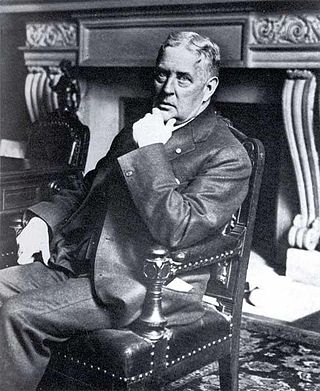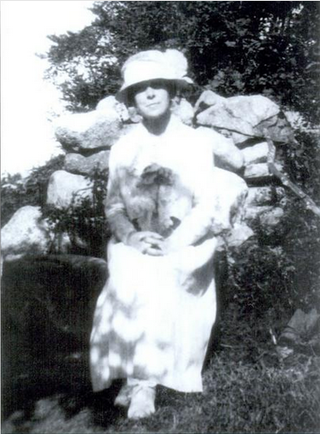
American Impressionism was a style of painting related to European Impressionism and practiced by American artists in the United States from the mid-nineteenth century through the beginning of the twentieth. The style is characterized by loose brushwork and vivid colors with a wide array of subject matters but focusing on landscapes and upper-class domestic life.

William Merritt Chase was an American painter, known as an exponent of Impressionism and as a teacher. He is also responsible for establishing the Chase School, which later became the Parsons School of Design.

Frederick Carl Frieseke was an American Impressionist painter who spent most of his life as an expatriate in France. An influential member of the Giverny art colony, his paintings often concentrated on various effects of dappled sunlight.

Joaquín Sorolla y Bastida was a Spanish painter. Sorolla excelled in the painting of portraits, landscapes, and monumental works of social and historical themes. His most typical works are characterized by a dexterous representation of the people and landscape under the bright sunlight of Spain and sunlit water.

Frank Weston Benson, frequently referred to as Frank W. Benson, was an American artist from Salem, Massachusetts known for his Realistic portraits, American Impressionist paintings, watercolors and etchings. He began his career painting portraits of distinguished families and murals for the Library of Congress. Some of his best known paintings depict his daughters outdoors at Benson's summer home, Wooster Farm, on the island of North Haven, Maine. He also produced numerous oil, wash and watercolor paintings and etchings of wildfowl and landscapes.

Divisionism, also called chromoluminarism, is the characteristic style in Neo-Impressionist painting defined by the separation of colors into individual dots or patches that interact optically.

The Boston School was a group of Boston-based painters active in the first three decades of the twentieth century. Often classified as American Impressionists, they had their own regional style, combining the painterliness of Impressionism with a more conservative approach to figure painting and a marked respect for the traditions of Western art history. Their preferred subject matter was genteel: portraits, picturesque landscapes, and young women posing in well-appointed interiors. Major influences included John Singer Sargent, Claude Monet, and Jan Vermeer. Key figures in the Boston School were Edmund C. Tarbell, Frank Weston Benson, and William McGregor Paxton, all of whom trained in Paris at the Académie Julian and later taught at the School of the Museum of Fine Arts. Their influence can still be seen in the work of some contemporary Boston-area artists.

The terms California Impressionism and California Plein-Air Painting describe the large movement of 20th century artists who worked out of doors, directly from nature in California, United States. Their work became popular in the San Francisco Bay Area and Southern California in the first three decades after the turn of the 20th century. Considered to be a regional variation on American Impressionism, the California Impressionists are a subset of the California Plein-Air School.

Edmund Charles Tarbell was an American Impressionist painter. A member of the Ten American Painters, his work hangs in the Boston Museum of Fine Arts, Metropolitan Museum of Art, National Gallery of Art, Smithsonian American Art Museum, Corcoran Gallery of Art, DeYoung Museum, National Academy Museum and School, New Britain Museum of American Art, Worcester Art Museum, and numerous other collections. He was a leading member of a group of painters which came to be known as the Boston School.

Cliff Rock - Appledore is an oil painting by American artist Childe Hassam, painted in 1903. It is part of the permanent collection at the Indianapolis Museum of Art.

Springtime or The Reader is an 1872 painting by the French Impressionist painter Claude Monet. It depicts his first wife, Camille Doncieux, seated reading beneath a canopy of lilacs. The painting is presently held by the Walters Art Museum.

Mary Brewster Hazelton was an American portrait painter. She attended the School of the Museum of Fine Arts, Boston, where she was later an instructor. Among her other achievements, Hazelton was the first woman to win an award open to both men and women in the United States when she won the Hallgarten Prize from the National Academy of Design in 1896. Her portrait paintings are in the collections of the Massachusetts State House, Harvard University, Peabody Essex Museum, and Wellesley Historical Society. The professional organizations that Hazelton was affiliated with included the Wellesley Society of Artists, of which she was a founding member, and The Guild of Boston Artists, of which she was a charter member. She lived her adult life with her sisters in the Hazelton family home in Wellesley, Massachusetts.
Beatrice Whitney Van Ness (1888–1981) was an American painter.












